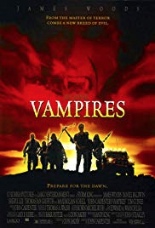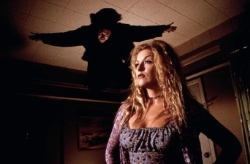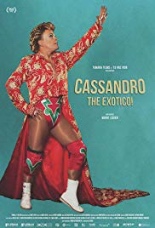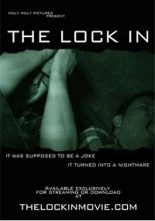
 Sometime in the 1990s, the unholy promise made by Near Dark was utterly fulfilled when Hollywood started to make purely American vampire flicks in the form of From Dusk Till Dawn, Blade and the underrated Vampires — or John Carpenter’s Vampires — that took the undead mythos and, with a bloody smirk, drove a stake right through them.
Sometime in the 1990s, the unholy promise made by Near Dark was utterly fulfilled when Hollywood started to make purely American vampire flicks in the form of From Dusk Till Dawn, Blade and the underrated Vampires — or John Carpenter’s Vampires — that took the undead mythos and, with a bloody smirk, drove a stake right through them.
Future hatemonger James Woods (Videodrome) leads the cast as acerbic vampire slayer Jack Crow, employed by the Catholic Church to do what he does best: make brutally caustic one-liners while lighting creatures of the night up like a cheap firecracker throughout the scenic desert landscapes of the Southwest. It’s all in a day’s work for Jack and crew until, at a whore-filled party, the vampire master (Thomas Ian Griffith, xXx) shows up and slaughters most of the affiliated hunters, drunken prostitutes and even a priest or two in his search for a relic known as the Béziers Cross that will allow him to walk in the sunlight, apparently the dream of most bloodsuckers.
 With the help of chubby sidekick Tony (Daniel Baldwin, Stealing Candy) and the novice Father Adam (Tim Guinee, Iron Man), they use pre-bitten hooker Katrina (Sheryl Lee, Twin Peaks: Fire Walk with Me) and her mental link with the master to track him and his nest of vampires down; she’s usually in one form or another of undress while doing this, which was great in 1998.
With the help of chubby sidekick Tony (Daniel Baldwin, Stealing Candy) and the novice Father Adam (Tim Guinee, Iron Man), they use pre-bitten hooker Katrina (Sheryl Lee, Twin Peaks: Fire Walk with Me) and her mental link with the master to track him and his nest of vampires down; she’s usually in one form or another of undress while doing this, which was great in 1998.
Loosely based on the novel Vampire$ by John Steakley, this movie was released during a mostly hit-or-miss time in final act of Carpenter’s career, coming in like a bat out of hell after the (somewhat) highs of Escape from L.A. , about to careen downward with the (somewhat) lows of Ghosts of Mars. It makes sense, though, as Vampires lie dead in the middle: a decently watchable 108 minutes, but by no means a final masterpiece. —Louis Fowler







 A group of overly caffeinated teens are on the way to a lock-in at their local church, all hoping to “get crazy” and help a friend possibly kiss a girl. On their way there, however, they stop by an area dumpster and find an old porno magazine; now, as a committed dumpster diver during the first half of the ’90s, believe me, the last thing you want in your hands is trashed porn, with layer after layer of grimy, stuck-together pages, simply dripping with the devil’s country gravy.
A group of overly caffeinated teens are on the way to a lock-in at their local church, all hoping to “get crazy” and help a friend possibly kiss a girl. On their way there, however, they stop by an area dumpster and find an old porno magazine; now, as a committed dumpster diver during the first half of the ’90s, believe me, the last thing you want in your hands is trashed porn, with layer after layer of grimy, stuck-together pages, simply dripping with the devil’s country gravy. The magazine is quickly discovered by Pastor Chris; his solution is to burn it outside as quickly as possible. A few minutes later, however, the magazine is back, showing up again in the backpack. When they try to throw it away, a demonic growl is heard and a garbage can is thrown down the hall. Fearfully moving down the stairs, the teens find themselves in a dark and empty church, and then the forced horror truly begins.
The magazine is quickly discovered by Pastor Chris; his solution is to burn it outside as quickly as possible. A few minutes later, however, the magazine is back, showing up again in the backpack. When they try to throw it away, a demonic growl is heard and a garbage can is thrown down the hall. Fearfully moving down the stairs, the teens find themselves in a dark and empty church, and then the forced horror truly begins.
 How does one earn the ceremonial title of Queen of the Jungle? In 15 minutes or less,
How does one earn the ceremonial title of Queen of the Jungle? In 15 minutes or less, 
